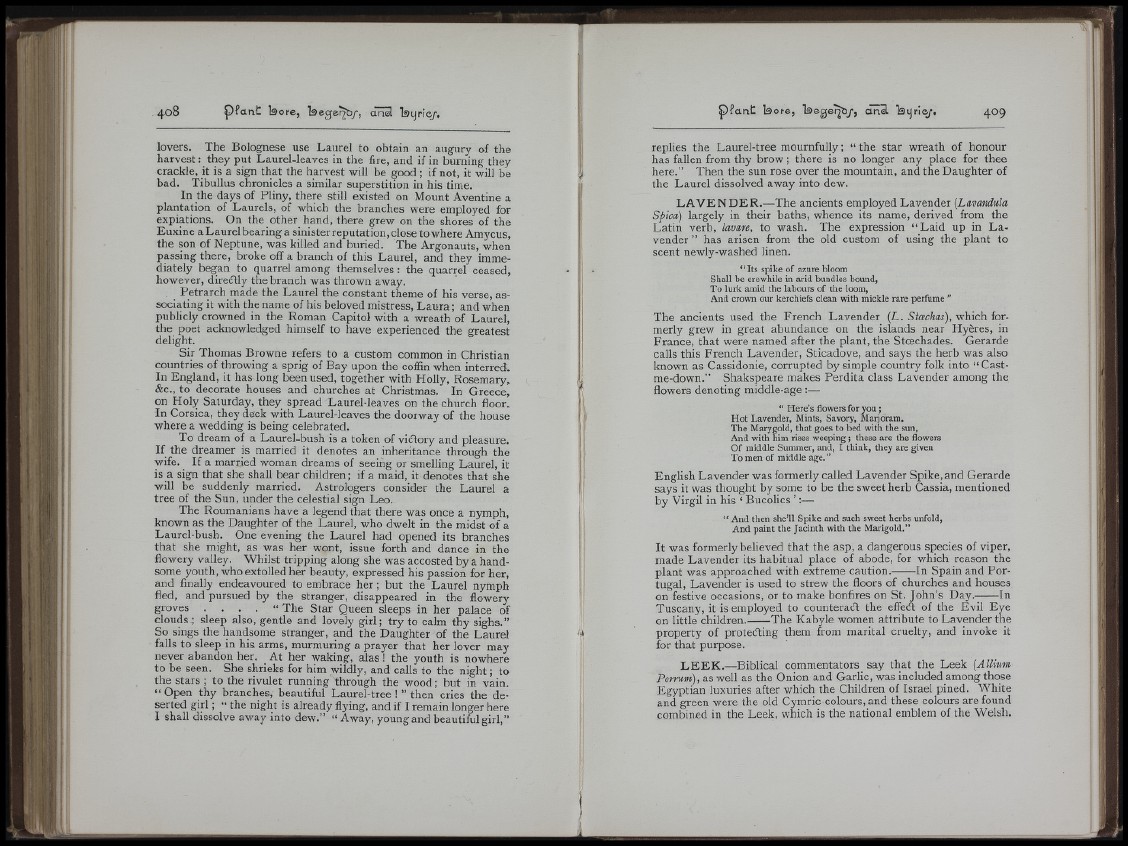
i n
Ü I •• l l; : !
i )
, :n i
lovers. The Bolognese use Laurel to obtain an augury of the
harvest; they put Laurel-leaves in the fire, and if in burning they
crackle, it is a sign that the harvest will be good; if not, it will be
bad. Tibullus chronicles a similar superstition in his time.
In the days of Pliny, there still existed on Mount Aventine a
plantation of Laurels, of which the branches were employed for
expiations. On the other hand, there grew on the shores of the
Euxine a Laurel bearing a sinister reputation, close to where Amyous,
the son of Neptune, was killed and buried. The Argonauts, when
passing there, broke off a branch of this Laurel, and they immediately
began to quarrel among themselves : the quarrel ceased,
however, diredtly the branch was thrown away.
_ Petrarch made the Laurel the constant theme of his verse, associating
it with the name of his beloved mistress, L a u r a ; and when
publicly crowned in the Roman Capitol with a wreath of Laurel,
the poet acknowledged himself to have experienced the greatest
delight.
Sir Thomas Browne refers to a custom common in Christian
countries of throwing a sprig of B a y upon the coffin when interred.
In England, it has long been used, together with Holly, Rosemary,
&c., to decorate houses and churches at Christmas. In Greece,
on Holy Saturday, they spread Laurel-leaves on the church floor.
In Corsica, they deck with Laurel-leaves the doorway of the house
where a wedding is being celebrated.
To dream of a Laurel-bush is a token of viiitory and pleasure.
I f the dreamer is married it denotes an inheritance through the
wife. I f a married woman dreams of seeing or smelling Laurel, it
is a sign that she shall bear children; if a maid, it denotes that she
will be suddenly married. Astrologers consider the Laurel a
tree of the Sun, under the celestial sign Leo.
The Roumanians have a legend that there was once a nymph,
known as the Daughter of the Laurel, who dwelt in the midst of a
Laurel-bush. One evening the Laurel had opened its branches
that she might, as was her wont, issue forth and dance in the
flowery valley. Whilst tripping along she was accosted by a handsome
youth, who extolled her beauty, expressed his passion for her,
and finally endeavoured to embrace h e r ; but the Laurel nymph
fled, and pursued by the stranger, disappeared in the flowery
groves . . . . “ The Star Queen sleeps in her palace of
clouds.; sleep also, gentle and lovely girl; try to calm thy sighs.”
So sings the handsome stranger, and the Daughter of the Laurel
falls to sleep in his arms, murmuring a prayer that her lover may
never abandon her. At her waking, alas ! the youth is nowhere
to be seen. She shrieks for him wildly, and calls to the night; to
the stars; to the rivulet running through the wood; but in vain.
“ Open thy branches, beautiful Laurel-tree ! ” then cries the deserted
g i r l ; “ the night is already flying, and if I remain longer here
I shall dissolve away into dew.” “ Away, young and beautiful girl,”
replies the Laurel-tree mournfully; “ the star wreath of honour
has fallen from thy brow; there is no longer any place for thee
here.” Then the sun rose over the mountain, and the Daughter of
the Laurel dissolved away into dew.
L A V E N D E R .—The ancients employed Lavender [Lavandula
Spica) largely in their baths, whence its name, derived from the
Latin verb, lavan, to wash. The expression “ Laid up in L a vender
” has arisen from the old custom of using the plant to
scent newly-washed linen.
“ Its spike of azure bloom
Shall be erewhile in arid bundles bound.
To lurk amid the labours of the loom,
And crown our kerchiefs clean with mickle rare perfume ”
The ancients used the French Lavender (L. Stoechas), which formerly
grew in great abundance on the islands near Hyeres, in
France, that were named after the plant, the Stoechades. Gerarde
calls this French Lavender, Sticadove, and says the herb was also
known as Cassidonie, corrupted by simple country folk into “ Cast-
me-down.” Shakspeare makes Perdita class Lavender among the
flowers denoting middle-age :—
“ Here’s flowers for you ;
Hot Lavender, Mints, Savory, Marjoram.
The Marygold, that goes to bed with the sun,
And with him rises weeping; these are the flowers
Of middle Summer, and, I think, they are given
To men of middle age.”
English Lavender was formerly called Lavender Spike, and Gerarde
says it was thought by some to be the sweet herb Cassia, mentioned
by Virgil in his ‘ Bucolics ’ :—
“ And then she’ll Spike and such sweet herbs unfold,
And paint the Jacinth with the Marigold.”
It was formerly believed that the asp, a dangerous species of viper,
made Lavender its habitual place of abode, for which reason the
plant was approached with extreme caution. In Spain and Portugal,
Lavender is used to strew the floors of churches and houses
on festive occasions, or to make bonfires on St. John’s Day. In
Tuscany, it is employed to counteraifi the effeift of the E v il Eye
on little children. The Kabyle women attribute to Lavender the
property of protecfting them from marital cruelty, and invoke it
for that purpose.
L E E K .—Biblical commentators say that the Leek [Allium
Porrum), as well as the Onion and Garlic, was included among those
Egyptian luxuries after which the Children of Israel pined. White
and green were the old Cymric colours, and these colours are found
combined in the Leek, which is the national emblem of the Welsh.